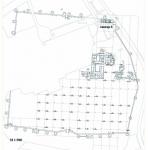Summary (English)
ABRITUS (Galena Radoslavova – galena_rz@abv.bg, Georgi Dzanev) The explorations of the buildings situated between Towers 9 and 10 along the inner side of the northern fortification wall continued in Sector 3. Two Early Mediaeval sunken-floored houses were discovered. The finds included sherds, including a bottom of a vessel with incised sign |Y| typical of the proto-Bulgars, a bronze cross–encolpion and an iron procession cross. Strata from AD 300 to AD 580 were documented beneath. Part of a building with two rooms, 13.80 m long, was discovered. The finds included sherds of the 6th century AD, mostly from amphorae, bronze coins of Anastasius I Dicoros and Justinian I. The foundations of the building were dug into earlier strata and foundations of another building were discovered there. It was 9.35 m long and dated to AD 480 – 525. The foundations of the building were dug into earlier strata and parts of five rooms were discovered there. Their lower parts of the walls, 1.30 m high, were constructed of stones and the upper parts were built of sun-dried bricks. The rooms were two-storeyed and their roof was covered with tegulae and imbrices. They had entrances with two-winged wooden doors and glass windows. The finds included sherds from bowls, pots, cups and amphorae, terracotta lamps and fragments from glass vessels. Judging from the coins, from Constantius II to Zeno, the rooms dated to AD 350 – 490. The rooms were burned. A corner of a building and a wall were discovered under the floor of the rooms. Judging from the coins, it dated to AD 300 – 340 during the reign of Licinius I and Constantine the Great.
- Galena Radoslavova - Regional Museum of History – Razgrad
Director
- Georgi Dzanev - Regional Museum of History – Razgrad
Team
Research Body
- Regional Museum of History – Razgrad






![Download [PDF]](/excavation/skins/fasti/images/results/download_sml.png)
